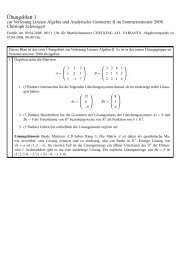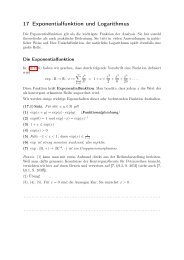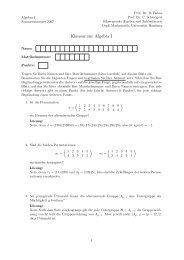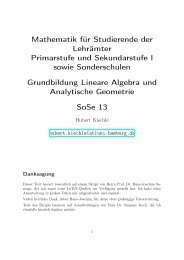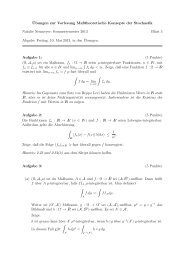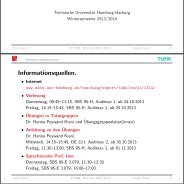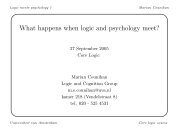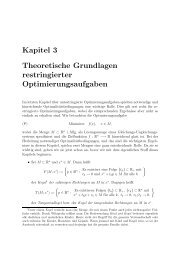pdf file
pdf file
pdf file
You also want an ePaper? Increase the reach of your titles
YUMPU automatically turns print PDFs into web optimized ePapers that Google loves.
Proof.<br />
Writing in a short form<br />
R = ∑ i<br />
(1 ⊗ e i ) ⊗ (e i ⊗ 1) = ∑ i<br />
e i ⊗ e i<br />
we find for the monodromy matrix of D(H)<br />
Q = R 21 ∙ R 12 = ∑ i,j<br />
(e i e j ) ⊗ (e i e j ) .<br />
The family e i e j = e i ⊗ e j is a basis of D(H) = H ∗ ⊗ H. Moreover,<br />
S(e i e j ) = S(e j ) ∙ S(e i ) = S(e j ) ⊗ S(e i )<br />
and since S is invertible, also e i e j is a basis of D(H). Thus by remark 4.4.7 D(H) is factorizable.<br />
✷<br />
We can treat a left action of H ∗ for a right coaction of H by<br />
Δ V :<br />
V id V ⊗b<br />
−→<br />
H<br />
V ⊗ H ∗ ⊗ H τ V,H ∗ ⊗id H<br />
−→<br />
H ∗ ⊗ V ⊗ H ρ⊗id H<br />
−→ V ⊗ H<br />
and conversely,<br />
ρ V :<br />
H ∗ ⊗ V id H ∗ ⊗Δ V<br />
−→<br />
H ∗ ⊗ V ⊗ H id H ∗ ⊗τ V,H<br />
−→<br />
H ∗ ⊗ H ⊗ V d H⊗id<br />
−→<br />
V<br />
V<br />
Put differently, we have<br />
f.v = 〈f, v (H) 〉v (V ) .<br />
The definition of the Drinfeld double D(H) has been made in such a way that the following<br />
assertion holds:<br />
Proposition 4.5.12.<br />
Let H be a finite-dimensional Hopf algebra.<br />
1. By treating the right H-coaction for a left H ∗ -action as above, any left D(H)-module<br />
becomes a Yetter-Drinfeld module in H YD H .<br />
2. Conversely, any Yetter-Drinfeld module in H YD H has a natural structure of a left module<br />
over the Drinfeld double D(H).<br />
(∗)<br />
Proof.<br />
We note that the structure of a left D(H)-module on a vector space V consists of the structure<br />
of an H-module and of an H ∗ -module such that for all f ∈ H ∗ , h ∈ H and v ∈ V the following<br />
consequence of the straightening formula holds:<br />
a.(f.v) = f(S −1 (a (3) )?a (1) ). ( a (2) .v ) .<br />
To show the second claim, we have to derive this relation from the Yetter-Drinfeld condition:<br />
f(S −1 (a (3) ?a (1) ). ( a (2) .v ) = 〈f, S −1 (a (3) )(a (2) v) (H) a (1) 〉(a (2) v) (V ) [equation (∗)]<br />
= 〈f, S −1 (a (3) )a (2) v (H) 〉a (1) v (V ) [YD condition]<br />
= ɛ(a (2) )〈f, v (H) 〉a (1) v (V ) [lemma 2.5.7]<br />
= 〈f, v (H) 〉av (V ) = a.(f.v) [equation (∗)]<br />
110






